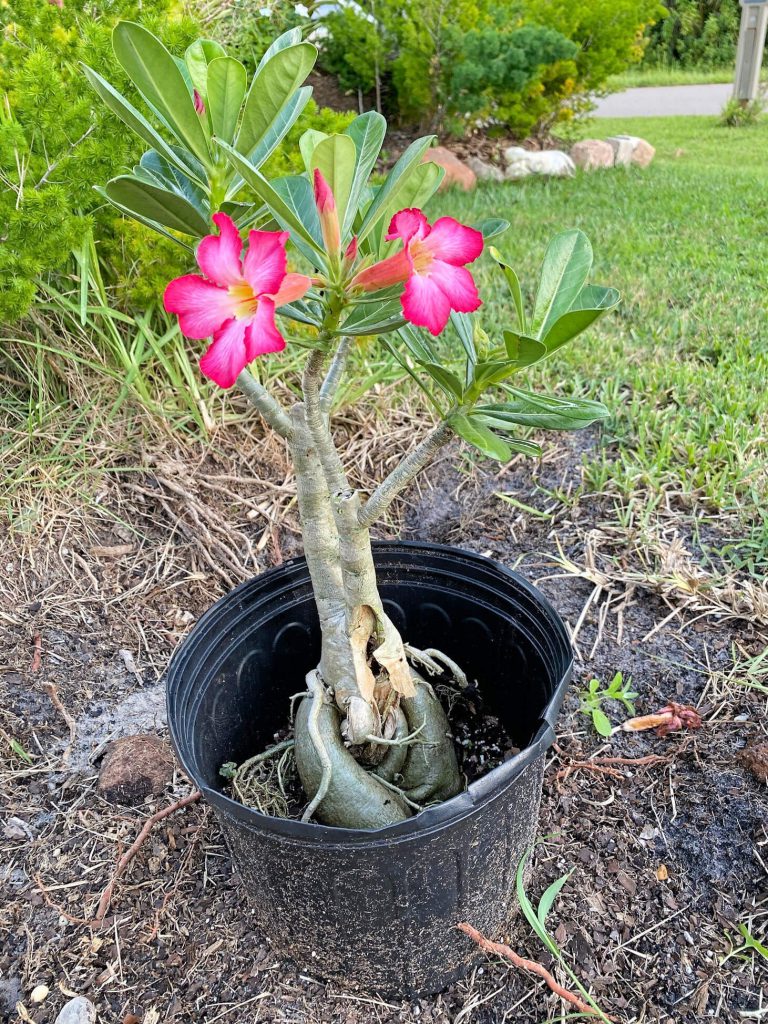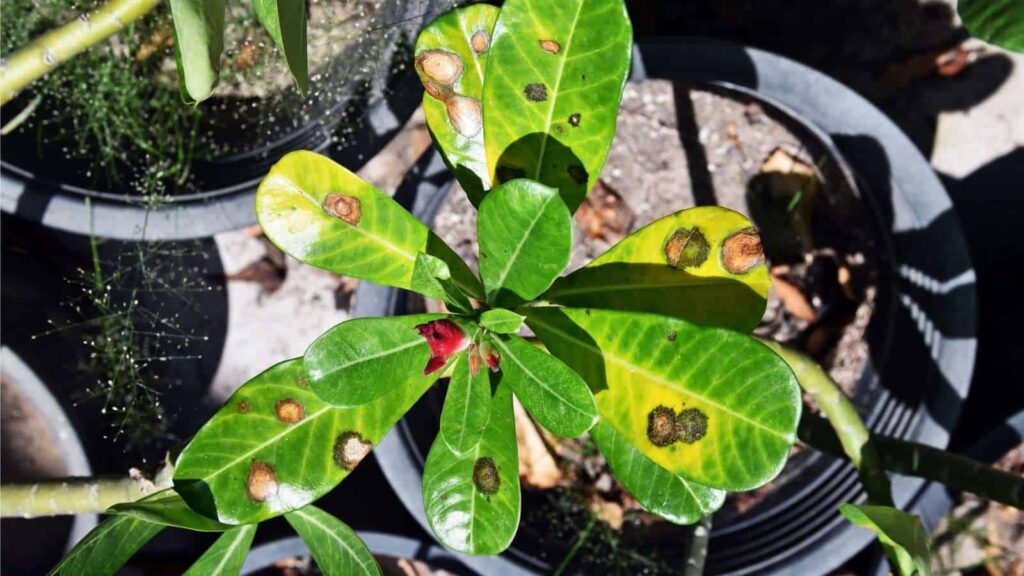The desert rose plant, or adenium obesum, is a low-maintenance houseplant that thrives in warm, sunny areas. It is easy to grow, but requires a bit of care to stay healthy.

Watering is a delicate dance—too much and you drown your plant, too little and it will scorch. To help your desert rose thrive, use a well-draining cactus/succulent potting mix.
Planting

Desert rose plants (Adenium obesum) grow from a thick succulent stem called a caudex, with branches sprouting leaves that can be green to variegated and trumpet-shaped flowers that range from red to pink or white. The plant has an overall squat, tree-like appearance and is often used in bonsai. Like other succulents, desert rose requires adequate sunlight and proper water management to thrive.
To propagate a desert rose plant from seed, first wet the seeds and soak them for several hours or overnight to rehydrate them. Sow the seeds about 2 inches apart in a pot of soil, and cover with more of the same soil. Water the soil regularly, and once the plants are well established, move them outdoors in a full-sun environment. When adeniums go dormant in fall and winter, pull back on the watering and allow the soil to dry out. Overwatering leads to root rot.
Indoors, desert rose plants require a south or west-facing window and highly porous potting mix. A potting mix with coarse sand and perlite or pumice is ideal to mimic the sandy desert soils where adeniums are native. Pots should have ample drainage holes. During spring through summer, keep the potting mix moist, but only water when it becomes dry at the top of the soil.
The most common pests to watch for are spider mites, which suck sap from the leaves and stems. Look for a speckled, powdery white substance on the underside of the leaf. Use horticultural soap or spray household alcohol to control infestations. Powdery mildew also afflicts the leaves, and is commonly seen during cool, damp nights and warm, sunny days. To combat this, mist the leaves and apply a fungicide to the underside of the leaves and stems according to instructions on the product label.
Care

Desert rose plants thrive in full sun and well-draining soil. The caudex, which stores water for the plant, can be prone to rot if the soil stays too wet. Keep the soil moist but not saturated, and feed with a 20-20-20 plant food at a dilution of only half as recommended during its growing season. Avoid watering during the winter months and allow the soil to dry out as it goes dormant.
When repotting your desert rose, choose a container that is slightly larger than the current plant’s rootball. A terra cotta pot is best as it allows the plant to breath. Also, be sure that the pot has drainage holes at the bottom. A commercially prepared potting mix is okay, but it should be amended with coarse sand, gravel, pumice or coconut coir. These materials help replicate the dry environment where the desert rose originates.
After repotting, water the plant thoroughly and place in a sunny location. As the plant grows, water it more frequently but still sparingly. A desert rose plant is a slow grower, so patience will be rewarded with bright blooms.
In the spring, propagate desert roses by using branch cutting or from seeds. Put on garden gloves to prevent the toxic sap from touching your skin. Using sterilized shears, cut a healthy branch with at least two leaves from the desert rose plant. Soak the cutting in warm water for a few hours or overnight to rehydrate it. Then, use rooting hormones to ensure successful germination. Place the seedling into a small pot with a free-draining potting mix that includes some coarse sand or pumice.
Pests

Tiny invaders like aphids, mites and scale insects can suck the life force of your desert rose, while caterpillars nibble at leaves and petals. Look for fine webbing, stippling and a sticky mess on stems and leaves to identify these sap-sucking menaces. A spritz of household alcohol or neem oil will send them packing. Hanging blue or yellow sticky traps nearby will also help nip infestations in the bud.
Powdery mildew shows up as blister-like marks on the leaves and stems. Misting with water and applying a fungicide as directed will treat mildew. Planting in well-draining soil, providing adequate space between plants and keeping humidity levels up will help reduce the risk of this fungal attack.
Chilli thrips are another troublemaker that will attack new growth, buds and flowers. Look for deformed blooms and leaves that look as if they went to war with a paintball gun (stippling). Spraying with a product containing spinosad will be necessary since the pest builds up resistance quickly.
Spider mites are the ninjas of the insect world, slipping around your plant undetected to do major damage. Identify them by the speckled appearance of the leaves, which are telltale signs that it’s time for a triple-threat of neem oil, insecticidal soap and alcohol.
Root rot is the silent killer of many houseplants, including desert roses. A few simple steps can prevent this problem: water only when the soil is dry, use a well-draining container, and provide adequate space between plants to reduce competition for water and nutrients. Adding a balanced fertilizer once per month will also support robust growth.
Diseases

Diseases can drain the life from a desert rose plant, slowing growth and limiting its ability to produce blooms. The best defense is preventive care. Water your plants regularly but not excessively, and avoid sudden changes in temperature. Overwatering can lead to root rot. Keep an eye out for a wrinkled caudex, which indicates that the plant is using up stored water. A damp potting mix may also indicate overwatering.
Fungus infections can form on the leaves, stems and flowers of desert rose plants, causing brown spots and distortions in growth. A fungal infection can also interfere with photosynthesis, impairing the plant’s energy production. A fungicide can treat fungal diseases.
Spider mites and mealybugs are common enemies of desert rose plants. Look for stippled leaves and sticky honeydew on the plant’s foliage or stems to detect these pests, which attack new growth and buds by sucking sap. You can nip them in the bud by washing the plants with a spray of household alcohol or hydrogen peroxide.
Powdery mildew can form on the leaves of a desert rose plant, especially if it’s grown in warm and humid conditions. The fungus can spread to other plants, so quarantine new specimens and move them away from other plants to stop it spreading. Spraying the plant with a forceful stream of water can help, too.
Adenium obesum extracts have been used for centuries in traditional medicine, and the plant is believed to have anti-cancer, anti-parasitic, and anti-microbial properties. Ingestion, however, is dangerous, and should only be done under a physician’s supervision. Ingesting the plant could cause nausea, vomiting and stomach cramps. The plant’s flower petals are also said to reduce anxiety, relieve indigestion, and reduce coughing and cold symptoms.
Repotting
Despite their eye-catching good looks, desert roses aren’t fussy plants. Like any plant, they eventually grow too big for their containers, becoming “pot bound” and slowing their overall growth and flower production. Repotting is the remedy, bringing fresh soil and renewed nutrients into your plant’s root system.
To repot your desert rose, first choose a pot 1 to 2 inches wider than the current one. It should also have plenty of drainage holes, as desert roses are prone to root rot in poorly draining conditions.
Soak your potting mix before you get started. This will allow it to be more easily handled and reduce the likelihood of making a mess on your hands. When you’re ready to start, gently coax your desert rose out of its old container. If it resists, a gentle tap or a little bit of squeezing may help. Next, prepare the new pot by screening in the drainage hole, and fill it up to a few inches from the top.
Once you’ve put your desert rose into its new container, give it a good watering, but don’t overdo it. These plants are more interested in sipping their water than gulping it, and soaking them for long periods of time can lead to root rot.
After repotting, place your desert rose in a bright spot that’s sheltered from direct midday sun. It prefers indirect sunlight, kind of like a sunny tan versus a sunburn. After it’s settled, fertilize with a well-balanced organic mix.
While you’re at it, you can prune your desert rose to control its size and shape. Prune dead or damaged leaves and stems, and remove any crossing branches. If you want to make it even more beautiful, try grafting different varieties of desert rose onto each other or onto other plants like oleanders to create artistic combinations.
